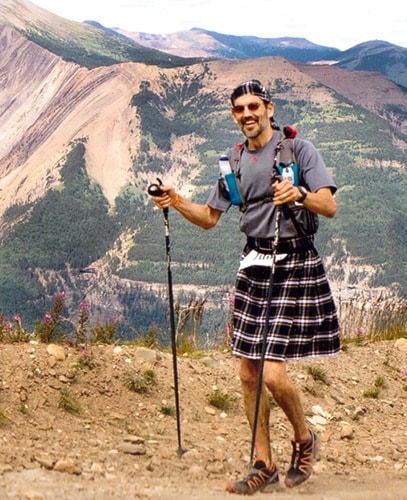One out of every three solo runners can’t complete the Canadian Death Race, a grueling 125 km race that takes a runner over thousands of feet of elevation and three mountain peaks.
Ponoka’s long-distance runner Slade McCormick was able to complete the race, which was held at Grande Cache, AB on Saturday, Aug. 1, as a solo runner in 17 hours, 17 minutes and 48 seconds and he placed 21st out of 326. While the times may seem slow for a typical long-distance race, the Death Race provides challenges not normally found on the open road.
“This was my fifth year of semi-serious running and I’d been to a number of races . . . and I wanted to see if I could do that,” said McCormick of his desire to run the 125 kms by himself.
The 47-year-old physical therapist had run longer 50 km races but nothing of this length. Training began in January.
Preparing for the race
Anticipation leading up to the race found McCormick nervous to run. He had some concerns his training was not good enough but as the race started, those doubts disappeared. McCormick’s goal was to enjoy the experience rather than worry.
“The race is a celebration of the training,” he stated.
Sporting a kilt during the race, McCormick used that as an opportunity to have fun and celebrate his Scottish heritage.
Once he completed the second leg, about 27 kms, McCormick felt confident he could complete it. The terrain was quite varying such that just when he thought he couldn’t finish a certain portion, the terrain would change and he would have to use a different set of muscles.
Not only did McCormick have to tackle steep climbs, he also had to stay mentally strong.
The Canadian Death Race has five legs, each one with a different set of challenges and a set time for completion. Each leg of the race had a specific name and time cutoffs. If a racer missed a cutoff, they would have to leave the race.
McCormick was asked to provide a name of his own for each leg as he saw them.
• Leg 1, 19 kms: the Prelude, which started in Grande Cache before making its way into the mountains.
• Leg 2, 27 kms: the Climb. This was the steepest leg of the race, where racers climbed the mountain. “It was a real technical course.”
• Leg 3, 21 kms: Recovery. This was still a technical run but did not have the, “grunt climbing we had been through.”
• Leg 4, 33 kms, the Grind. This is a big climb up almost 7,000 feet. “You finally get over the peak and you get to come back down.”
• Leg 5, 25 kms: the Finale. Much of this leg was run at night following the path of the riverbank. “When we hit the river you actually have to get on a speed boat to cross the river.”
Paying to cross the ferry
All of his effort would have been for nothing if McCormick didn’t have his special Death Race coin to pay what organizers call “the Ferryman.”
Every racer gets a coin to pay the Ferryman and if they do not have this coin they cannot complete it. “It happens every year. People lose their coin and their race ends.”
Being able to pay the Ferryman and cross the river was a big relief for McCormick.
Keeping the energy up required regular hydration and food ideal for the environment plus a special blend of syrups, maltodextrin powder and honey heated on the stove. “It tastes like caramel.”
“The more different kind of sugars you can get in you, the better you have of maintaining those energy levels,” explained McCormick.
Different sized feet and completing the race
Knowing he was going to complete the race was a moment of celebration. “It was just a wash of relief.”
Something most people don’t realize about McCormick is he has two different sized feet. His right foot is size 13 and his left size 10.5 and he has to buy two pairs of shoes for a running event.
In preparation for this race McCormick brought five pairs of matched shoes. So he had to buy 10 pairs to change them out after each leg of the race to avoid blisters.
As his mind wandered during the race, McCormick said he felt a strong sense of gratitude for being able to compete. “It’s a special feeling, and recognizing as well that I didn’t do it on my own. I had the support of my family.”
During training, he ran almost every day and at times for hours. His family supported the effort and were there at each transition stage.
The physical toll of the Death Race was not felt until he finished. McCormick celebrated with family, took a shower and then could not stop shivering.
“I had been going for so long all day maintaining as even of an effort level as I could that when I finally did stop, and the realization hit of what I accomplished, my body just shut down a little bit,” said McCormick.
Another competitor McCormick completed the race with had the same issue after the race. “It takes a toll on your body.”
McCormick’s children Zoe, Rowen, Gabriel and Findlay took part in the kids’ death race, which was five kilometres long. Zoe finished second in her age category.
